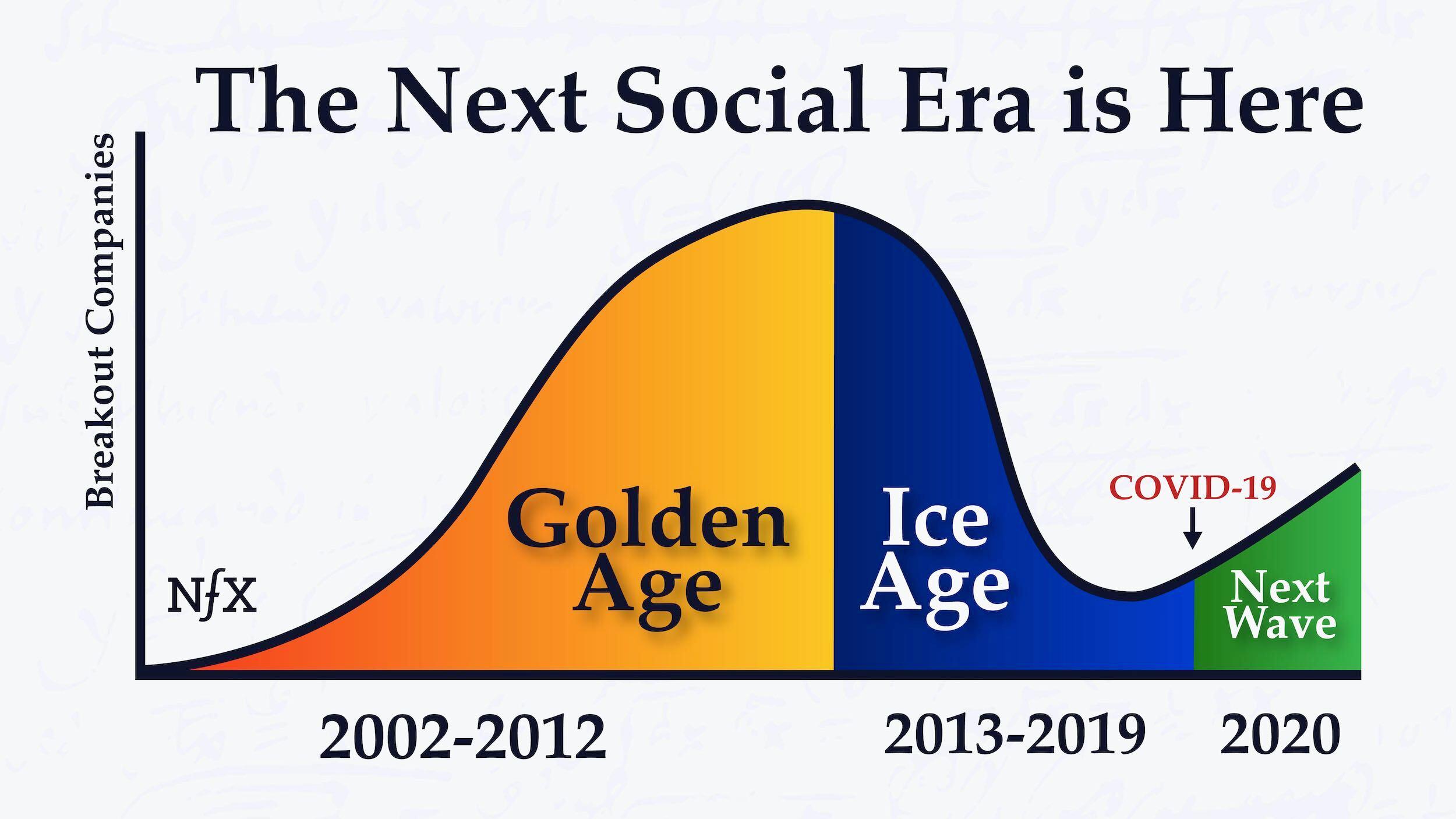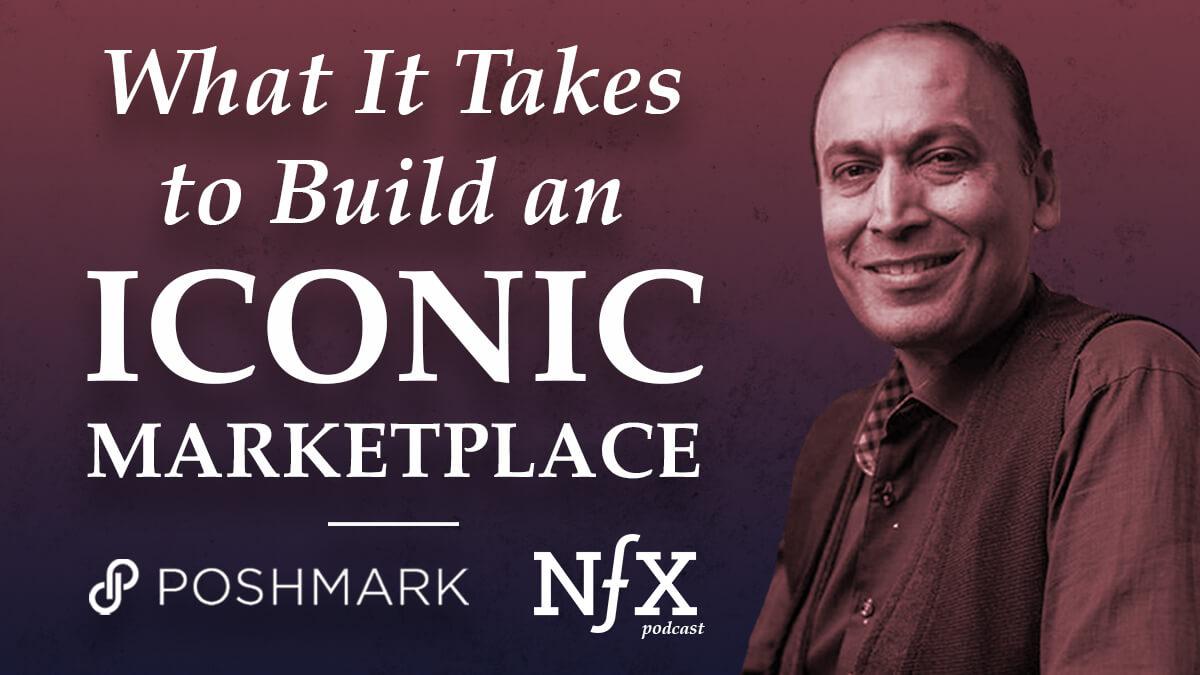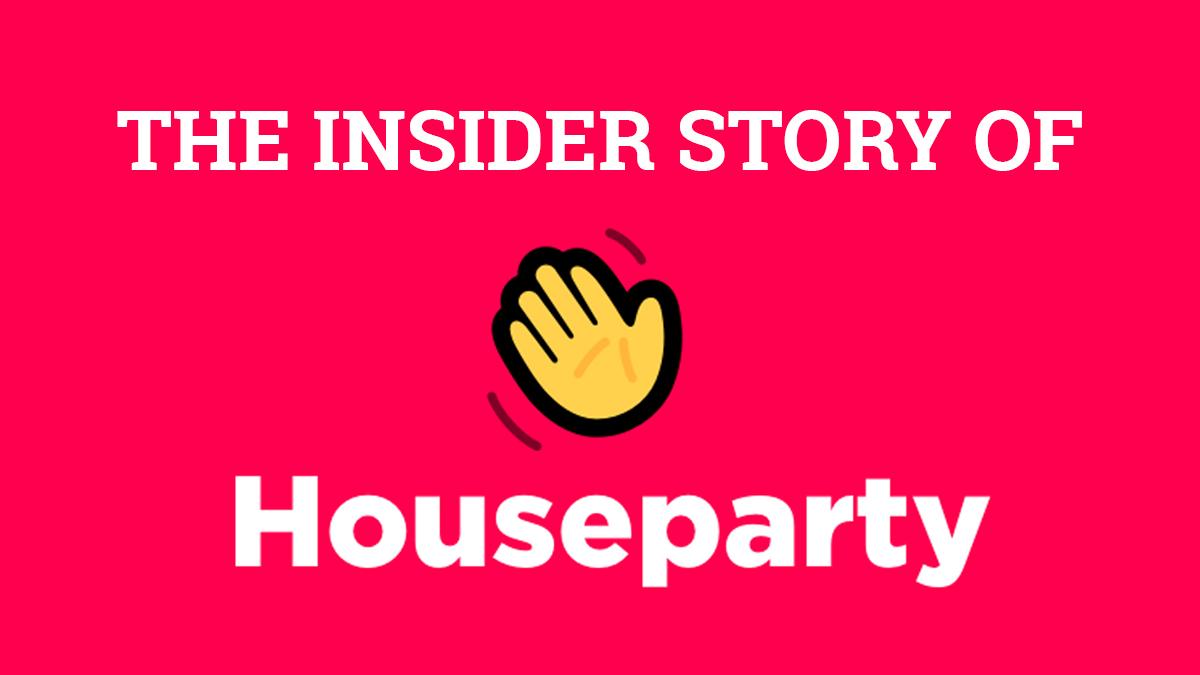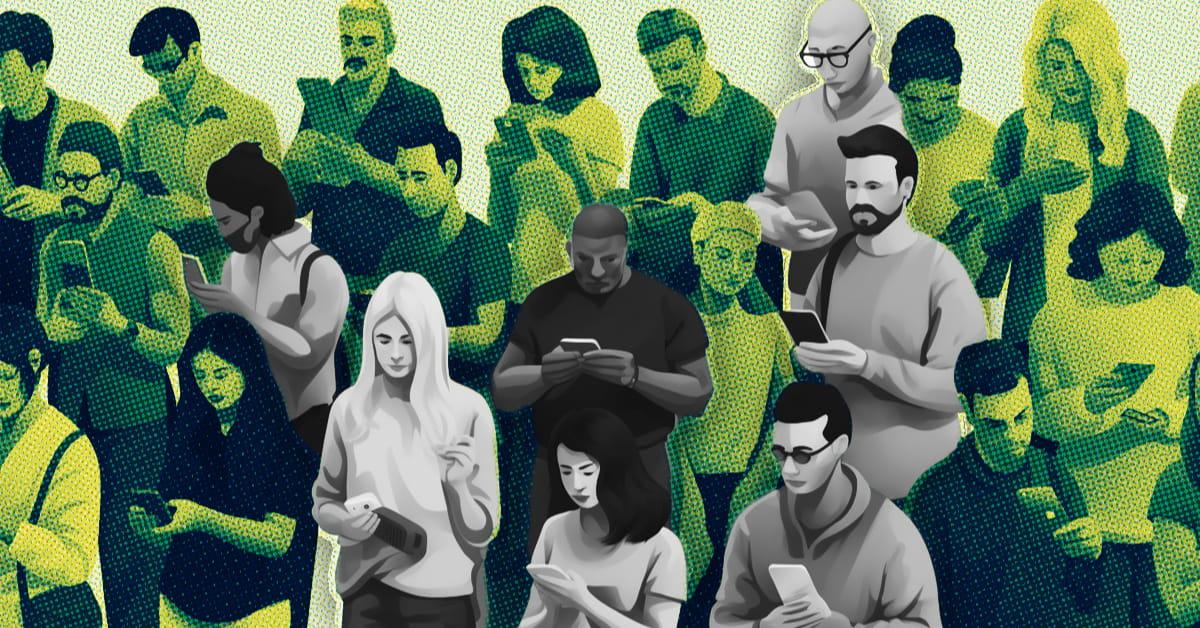

Now is the best time in eight years to be a Founder of social/communications products, and we believe it will kick off a second wave of product-first Founders who are true artists of their craft.
The Social Media Golden Age of 2002- 2012 was mostly consumer-focused. The Golden Age gave us companies like LinkedIn, Facebook, Twitter, Snap, Instagram, Whatsapp, Hangouts, Poshmark, Slack, Zoom, Gmail, and Dropbox.
In the subsequent 8 years, outside of Asia, few companies emerged on the consumer side other than Discord and Musical.ly/TikTok. The most useful way we have of explaining why is that the psychological and emotional needs of people were largely met. Those Golden Age companies covered the ground. There were no more reservoirs of need that were big enough to power the formation of another network.
As a Founder and investor, these eight years of drought have been disappointing because that Golden Age was vibrant. Those social media products were fun to build, fast to grow, colorful, visible, impactful. They also produce the strongest, most durable direct network effects and thus high potential companies.
These types of software products are the most artistic corner of the tech world. Like movies and music, the subtle details matter. Facebook, for instance, was perhaps the 40th social network built with essentially the same 5 features but emerged as the titan through a series of subtle differences, some lucky, but most due to talent.
Fortunately, there are two things happening now that could crack the ice and make this a great time to get back to social product artistry.
First, the pandemic is creating a new topology of psychological and emotional needs. Digital media and social products are no longer distractions, they are central to the functioning of society. “Social” and “network” is at the core of how we function, and increasingly at the core of how we relate to ourselves and project our identities. Technologies that help us work and live digitally are finally achieving real liftoff. Zoom just jumped from 10 million to 200 million+ daily active users. Houseparty skyrocketed to become #1 on the App Store, adding 50 million new signups in one month (disclosure: we invested early-on). The pandemic is not only speeding up technology adoption, it’s rewiring our relationship to it.
It could be a big enough shift so that the new psychological and emotional needs will not be served only by the incumbents, but by new companies starting now.
Second, the work environment is now open game for new social products. Two reasons for this. First, we see how good communication can be with consumer products and demand the same excellence in our work lives. But second, and newer, is that in the last few months, the distance between our work identities and our home identities have blurred. There’s a fundamental shift. We are becoming more exposed, authentic, and integrated, as we see our business counterparts in their homes with their cats, their kids, their spouses, un-showered. Starting perhaps with this video from the BBC in March 2017.
So for the first time in decades, our emotional and psychological needs are changing, both in our consumer lives and our work lives, which means now is the first time in 8 years that it could be a good idea to found a social media app or communications tool.
A warning, however. Because these social communication tools are delicate to design and as artistic as we get in the tech world, there aren’t many Founders who can pull it off. Among many other qualities, the Founders who build and evolve these products must have great design skills, be masters of A/B testing, and must have an intuitive sense of language, feel, and psychology. It’s not for everyone.
We will be publishing a series of essays and podcasts discussing the nuances of building such products. We already published one with Manish Chandra, Founder and CEO of the social shopping app Poshmark.
Today is the next installment. Below we include key excerpts from an NFX podcast with my long-time friend Josh Elman. Josh has been one of Silicon Valley’s top social media people for 20 years. As a product manager, Josh had a hand in Real Networks, LinkedIn, Facebook, Twitter and Robinhood. As an investor with Greylock for 8 years, he navigated the social media Ice Age nearly perfectly, investing in two of the three biggest hits TikTok (musical.ly) and Discord.
Three Rules for Creating a Great Social Product
The best product builders understand that great “social” means creating something that compels our humanity and our psyche. It’s the secret of every iconic social company that’s ever been built. In studying and investing in these companies, we’ve learned that there are three things a social startup must have if it is going to be successful:
1. Own a new habit
- You need to create a new habit and then own it by building the social center of that habit. Habit formation starts small but can snowball quickly to have extraordinary gravitational pull for you and others. But, importantly, the habit really does need to be something new. It’s much harder to break old habits and dislodge incumbents.
- Josh says: As investors, we thought people were going to start recording a lot more videos. So we looked for places that could become a hub of short-form videos, and that was Musical.ly.
- Josh says: As investors, we thought people would want better tools for social interactions while gaming together — a relatively new habit. This led us to Discord.
2. Be super sticky
- The habit you build should become a central part of each user’s life. Users should tell you, “If I’m bored, I will go and use the app.” This is stickiness. This is staying power. This is an emotional need.
- More important than huge numbers or growth is demonstrating strong traction with a small group of users. You are completely solving a need for them and they swear by your product. This means you have a chance to build a deep, meaningful connection for people. This is more important than ever.
- This is how Facebook grew, by the way; Mark Zuckerberg focused on growing in universities where he knew his product-market fit was incredibly strong. It was a smart strategy to build a sticky initial user base.
- Social Founders must be users of their own product, and not just because they are doing QA. If they are not using the products themselves, and do not have a habit of using the product, that’s a red flag.
3. Find a Strong and Obvious Growth Hook
- There should be a very obvious path to relatively low-friction, low-cost growth. “Hey, if this small group of people is using it, here’s why they want more people to join them, and here’s how this will expand and this will grow and this will rise above the noise.” Actually role-play that conversation before you build anything.
- The growth hook should be owned by the startup. You cannot be dependent on something controlled by someone else to power your growth. Meerkat got crushed because its growth hook — the Twitter API — got shut off.
- People should want to share the social product because it will make their own experience directly better, and not in an abstract way. With Discord or Houseparty, you want your friends to be with you in the product. So you share it with them. Instant gratification, instant connection. No one cares about your network effects. They care about having a better time because more people are around.
The Last 6 Years Have Been an Ice Age for Social Tools
In the U.S., Facebook, Snapchat, Twitter, LinkedIn, and Instagram have fulfilled our emotional online needs for the last 5-6 years. Most of us use some or all of these applications frequently, if not daily. But our social experiences have been focused on consumption more than creation; on quick emoji reactions more than deep feedback; on building ‘promotional’ channels more than personal connections.
As a result, we have been in a social media ice age for the last few years, with only a small handful of new social companies (notably Discord and Musical.ly) creating online experiences with network effects.
How we got to this point:
- The social web started with personal homepages and mini-websites, and evolved to communities of bloggers and instant messaging and chat rooms (AOL). Social then progressed to early versions of social networks, where you could create a dynamic online “real” representation of yourself for work (LinkedIn) or real-life (Facebook) with status updates and news feed and all the bells and whistles we’ve come to know and accept.
- These networks also exposed us all to the power of the extended network — being able to see who your friends know — codifying the concept of a “social graph,” the aggregate network of someone’s connections across various social networks.
- Then, of course, social made the seismic shift to mobile. With that jump, we moved toward more real-time, in-the-moment updates and visual experiences… photos and videos galore. People used social media to broadcast to the world a personalized reality show, but the outcome was, ironically, sharing a less authentic personality and more curated “media.”
What made early social media so wonderful — the shared, intimate connections, and time spent together with loved ones and friends — had receded.
Key Observations:
1. For the last 6 years, social platforms have done a pretty good job of sticking around. People use more than one of them to fill different needs or to communicate with different groups. This is where we have been for the last decade of social media. For example, one person might use Facebook for communicating with family, Twitter for communicating in the startup community, LinkedIn for communicating with prospects, Instagram for sharing pictures with friends, or Snapchat for goofing around with friends.
2. Social graph network effects are exceptionally sticky, which makes it painful for a user to move from one network to another. This creates tremendous inertia. When you post a video on Facebook and everyone in your family says how much they like it, why would you move to a new social network where none of your family is?
3. Our networks, habits, audiences, and feedback expectations grew so big and so dense, that it became hard for most of us to imagine something new that could possibly address some unfulfilled need.
4. Social media became more media and less social.
5. During this static period, we did get hints at what might come next with TikTok (Musical.ly) and Discord. TikTok changed the game by making short-form video easy to make, fun, and viral in ways that Vine and Meerkat took a swing at but never accomplished. Discord brought all of online gaming onto the same voice and text chat platform, creating a “Ready, Player One” experience machine. This made online gaming much richer and more of an intimate shared experience.
6. Bright spots in social media appear when we see a better balance of creation with consumption. Exciting to see TikTok focus on creation over the passive consumption of Instagram.
7. There is a growing demand for intimate shared online experiences around doing things we love.
8. Connection is becoming less about asynchronous consumption and more about real-time togetherness.
The Next Era of Social Applications is Emerging
Sudden shelter-in-place on a mass scale has created new emotional and social needs, which are rapidly thawing the inertia of our social media ice age. What we are finding — and what the next wave of social is already demonstrating — is that it is possible to create shared, intimate moments and experiences online that are no longer dismissed as “less real” than physical, in real-life experiences.
At the same time, the demand for new online interactions has never been greater. This is exposing massive and exciting white spaces that are now emerging at a blazingly fast pace, even week-by-week, as we try mightily to find new joy in connection.
COVID-19 won’t last forever, but it has triggered a seismic shift in social thinking across many facets of life that will not disappear.
Key Observations
1. What’s really special about what’s happening right now is that we’re normalizing and improving on a lot of behaviors and platforms that have been out there for a while.
2. Take the example of Zoom — it’s been around for a while and has been an exceptional workplace video conferencing product. But it always felt second-rate to get on a Zoom vs. trying to have a meeting in person. The luxury of choice made us deprioritize Zoom. No more.
3. What shelter-in-place is doing is making us all pause and say, “What if this is the default? How do we then learn new norms and operate and make sure that this is as effective as possible?”
4. We will need to have far better tools to connect, share content, and share information. We will learn to replicate the important parts of in-person experiences and bring them to our digital tools.
5. Now consider the combinations. Take Zoom and combine it with online poker. People have been playing online poker for years. But add Zoom, and you are much closer to playing poker with your friends — talking and laughing and staying up until 1 am together. Zoom becomes the Discord for the rest of society.
6. There’s an opportunity to make this experience of playing games together online even better, and to realize it’s not about ‘entertainment’ but about core human connection, social validation and friendship.
7. A lot of interesting things are happening online around music right now, that probably will only accelerate. Previously we live-streamed concerts but it was always perceived as much lamer than being there in person. Now we are seeing performances streamed online that are of exceptional quality and have a sense of intimacy and connection that we might not even feel at a concert. John Legend is sitting there at home singing to you!
8. Check out the performance by the cast of “Hamilton.” They sang the opening number from the show from their apartments over Zoom, for a little girl named Aubrey who had missed her chance to see Hamilton “live” due to the COVID lockdowns. The definition of a live music experience shifts from “in person” to “happening right now.”
9. What if we invent even better tools to make music an intimate and shared experience? Spotify already gave us streaming and curation, but the opportunity now is to build great products that give us more “live” experiences.
10. We are moving away from treating social media as another promotional channel, and being conditioned toward lightweight (more pejoratively: shallow) interactions. Perhaps our move toward more meaningful connection is a silver lining of the shelter-in-place orders and an opportunity for the future.
11. What was being shared, pre-COVID, was less and less reflective of the actual people we love interacting with.
12. Being social is really the art of being together — conversing, engaging, sharing experiences, sharing moments, telling a joke, and hearing a friend’s laughter instantly (not just in a laugh emoji).
13. COVID underscores for us — as society, as Founders, as investors — the lack of these emotional connections on most existing social media platforms. Right now, Instagram is pretty boring. People aren’t going out and doing all these cool things that they’re showing off in photos. We are seeing energies and preferences shift towards more meaningful forms of sharing and social communication — towards Instagram Live, Houseparty, Discord, phone calls, Zoom poker nights. Those experiences are less about broadcasting over social media than they are about building and enjoying a social connection.
14. It’s science! When you’re talking to somebody, you have so much more adrenaline and endorphins and connections between you two. Even if it’s just a phone call, it’s better if it’s a video call and you’re making eye contact. This shouldn’t go away.
15. Very important shift toward creation, not just consumption. On Snapchat or Instagram, it often takes longer to consume social content than to create it. It’s the opposite for TikTok. Someone might spend hours working on a funny dance routine. Spending time practicing dance moves with your friends is a really amazing and intimate social activity. TikTok is reverting us back to a world of creators.
16. Importantly, TikTok makes it relatively easy to look good. It democratizes the skill of short-form video creation.
17. To their credit, as well, TikTok has purposefully prevented a small handful of talented “influencers” from dominating the scene — a flaw that discouraged more people from making Vines. TikTok tunes the feed so users are always seeing something new.
18. TikTok is the beginning of what will become a much bigger and broader trend towards creating experiences for friends and family online.
What if…
- Josh’s dream social network would show how long a creator spent making a post. Say you go on a trip and make a collage, and it says, “Hey, James just spent three days curating these pictures from this amazing trip he did. Would you like to look at it?” Yes, people definitely would be more likely to look at it if they knew James had put a lot of time and care into creating it.
- What if we could give all amazing musicians a tool where they can set up a private jam session and charge $50 or $100 per person to join for an hour or two and have a very intimate live video chat experience where you can have one on one conversation. You can know everyone else sitting there in the virtual space with you. We’ve seen artists do many online jam sessions. There’s a great space for someone to build products that can actually allow artists to run these things.
- What if we could all cook lunch together remotely? We called the idea Lunch Buddies. Everyone would gather their ingredients and start cooking at the same time. If your eggs were sticking to a pan, you could ask someone for help. You could even hire a professional chef to teach you and some friends how to make a souffle or a perfect Sicilian pizza. What’s a better way to build fellowship and share humanity than to eat together?
- What if social media can be used to make online work environments better? For example, email threads and meetings online tend to get hijacked by the lowest common denominator. Someone says “Terrible idea!” and the rest of the thread in a meeting or a Slack is responding to that response. So the loudest voices dominate conversations and set the tone even more strongly in remote work settings.
- What if you could timeshift feedback and have everyone enter their thoughts or ideas or feedback in advance, and then they are all shared simultaneously? This would potentially reduce the prominence of the loudest voices and allow conversations and discussions to take more organic directions. Would it make work more fulfilling and allow more voices to be heard?
- There is a staggering amount of potential, right now, for figuring out new tools and ways to make remote and distributed work better. To bring humans together, better, and sharing new experiences.
Unprecedented Opportunity for Social Experiences
Never before in the Internet Age have we had such a drastic and rapid shift of behavior by the entire global population. We are in uncharted territory. Yet, our human needs are the same as ever. We need companionship, friendship, and connection.
At work, we need a sense of togetherness and team. We need communication and feedback and respect and learning. In our social media, we need, well, love. We’re already moving away from broadcast mode and towards a mode of more intimacy and sharing.
Shelter-in-place has accelerated the pace of ongoing changes in how we work and live and spend time. This kind of dire disruption means we are all more willing to try new things and construct new modes of experiences.
The social internet was frozen in place only a few months ago — ruled by incumbents, governed by existing behaviors, feeling overly promotional, and slowed by lack of appetite or need for something new. Now the ice has broken and new social experiences are being invented daily, at work, in virtual classrooms, and in our personal lives. Driven by the need for human connection, these new social experiences are rapidly becoming routines and habits we won’t soon abandon. The most insightful Founders around us are seeing which of these habits are going to become a new normal. Which are the seeds of inspiration for creating new human experiences online?
As Founders ourselves, we respect your time. That’s why we built BriefLink, a new software tool that minimizes the upfront time of getting the VC meeting. Simply tell us about your company in 9 easy questions, and you’ll hear from us if it’s a fit.




